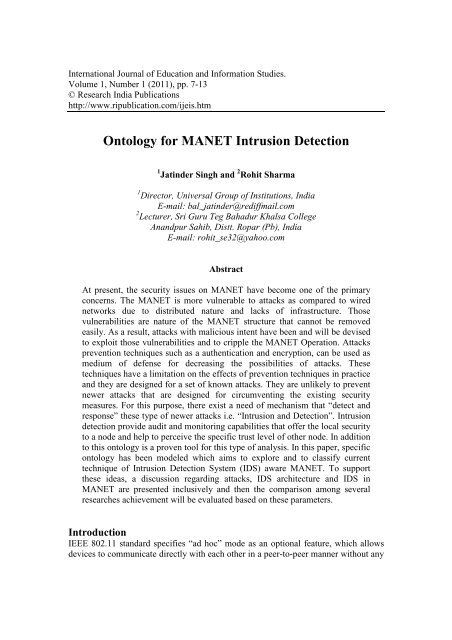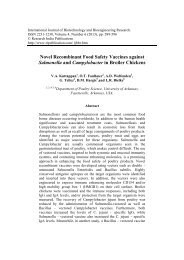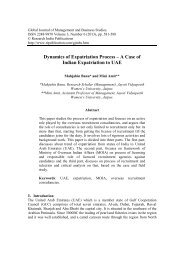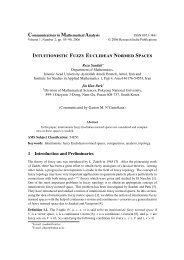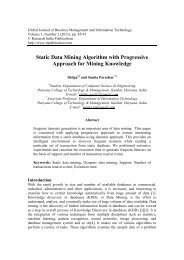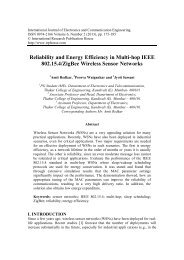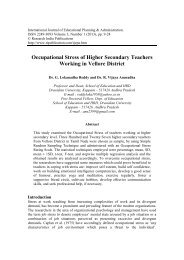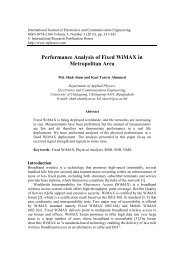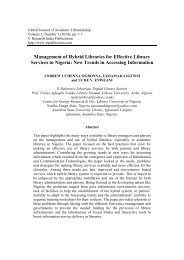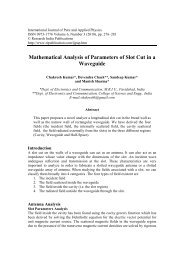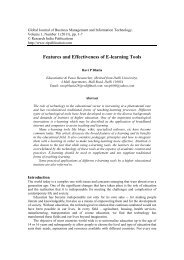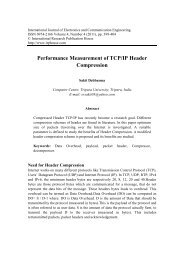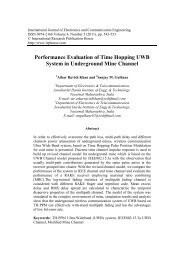Ontology for MANET Intrusion Detection - Research India Publications
Ontology for MANET Intrusion Detection - Research India Publications
Ontology for MANET Intrusion Detection - Research India Publications
Create successful ePaper yourself
Turn your PDF publications into a flip-book with our unique Google optimized e-Paper software.
International Journal of Education and In<strong>for</strong>mation Studies.Volume 1, Number 1 (2011), pp. 7-13© <strong>Research</strong> <strong>India</strong> <strong>Publications</strong>http://www.ripublication.com/ijeis.htm<strong>Ontology</strong> <strong>for</strong> <strong>MANET</strong> <strong>Intrusion</strong> <strong>Detection</strong>1 Jatinder Singh and 2 Rohit Sharma1 Director, Universal Group of Institutions, <strong>India</strong>E-mail: bal_jatinder@rediffmail.com2 Lecturer, Sri Guru Teg Bahadur Khalsa CollegeAnandpur Sahib, Distt. Ropar (Pb), <strong>India</strong>E-mail: rohit_se32@yahoo.comAbstractAt present, the security issues on <strong>MANET</strong> have become one of the primaryconcerns. The <strong>MANET</strong> is more vulnerable to attacks as compared to wirednetworks due to distributed nature and lacks of infrastructure. Thosevulnerabilities are nature of the <strong>MANET</strong> structure that cannot be removedeasily. As a result, attacks with malicious intent have been and will be devisedto exploit those vulnerabilities and to cripple the <strong>MANET</strong> Operation. Attacksprevention techniques such as a authentication and encryption, can be used asmedium of defense <strong>for</strong> decreasing the possibilities of attacks. Thesetechniques have a limitation on the effects of prevention techniques in practiceand they are designed <strong>for</strong> a set of known attacks. They are unlikely to preventnewer attacks that are designed <strong>for</strong> circumventing the existing securitymeasures. For this purpose, there exist a need of mechanism that “detect andresponse” these type of newer attacks i.e. “<strong>Intrusion</strong> and <strong>Detection</strong>”. <strong>Intrusion</strong>detection provide audit and monitoring capabilities that offer the local securityto a node and help to perceive the specific trust level of other node. In additionto this ontology is a proven tool <strong>for</strong> this type of analysis. In this paper, specificontology has been modeled which aims to explore and to classify currenttechnique of <strong>Intrusion</strong> <strong>Detection</strong> System (IDS) aware <strong>MANET</strong>. To supportthese ideas, a discussion regarding attacks, IDS architecture and IDS in<strong>MANET</strong> are presented inclusively and then the comparison among severalresearches achievement will be evaluated based on these parameters.IntroductionIEEE 802.11 standard specifies “ad hoc” mode as an optional feature, which allowsdevices to communicate directly with each other in a peer-to-peer manner without any
8 Jatinder Singh and Rohit Sharmaaccess points. In <strong>MANET</strong>, no fixed infrastructure, like base station or, mobileswitching center is required. Instead, every possible wireless mobile host within theperimeter of radio link acts as an intermediate switch and participates in setting up thenetwork topology in a self organized way. Ad hoc network supports multi-hoprouting, thereby extending the range of mobile nodes well beyond that of their basetransceiver. This can extend the range of the wireless LAN <strong>for</strong>m hundreds of feet tomiles, depending on the concentration of wireless users. Other advantages includeeasy installation, less maintenance, flexibility, and it is ideally suited <strong>for</strong> disastermanagement (fire, earthquakes etc.), military operations and critical missions. Also,apart from traditional use in office environments, <strong>MANET</strong> targets domesticnetworking market as it allows interconnection of various entertainment device at acompetitive cost [30].There are several multi-hop routing protocols have been proposed <strong>for</strong> <strong>MANET</strong>,and most popular ones include: Dynamic Source Routing (DSR), Optimized Link-State Routing (OLSR), Destination-Sequenced Distance-Vector (DSDV) and Ad HocOn-Demand Distance Vector (AODV), Most these protocols rely on the assumptionof a trustworthy cooperation among all participating devices; un<strong>for</strong>tunately, this maynot be a realistic assumption in real systems. Malicious nodes could exploit theweakness of <strong>MANET</strong> to launch various kinds of attacks.Node mobility on <strong>MANET</strong> can not be restricted. As results, many IDS solutionshave been proposed <strong>for</strong> wired network, which they are defined on strategic pointssuch as switches, gateways, and routers, can not be implemented on the <strong>MANET</strong>.The rest of this paper will be structured as follows. Section 2 describes history andbackground of the IDS in <strong>MANET</strong>. The <strong>Intrusion</strong> detection on <strong>MANET</strong> is presentedon section 3. In section 4, we present a discussion regarding the IDS classification.Finally, the ontology <strong>for</strong> <strong>MANET</strong> in section 5.History and Background of IDSActually, system administrators per<strong>for</strong>med intrusion detection by sitting in front of aconsole and monitoring user activities. They might detect intrusions by noticing, <strong>for</strong>example, that a vacationing user is logged in locally or that a seldom-used printer isunusually active. Although effective enough at the time, this early <strong>for</strong>m of intrusiondetection was ad hoc and not scalable.An intrusion-detection system (IDS) can be defined as the tools, methods, andresources to help identify, assess, and report unauthorized or unapproved networkactivity. <strong>Intrusion</strong> detection is typically one part of an overall protection system that isinstalled around a system or device - it is not a stand-alone protection measure.Depending on the detection techniques used, IDS can be classified into three maincategories [6] as follows: 1) signature or misuse based IDS, 2) anomaly based IDS, 3)Specification based IDS, which it is a hybrid both of the signature and the anomalybased IDS.The signature-based IDS uses pre-known attack scenarios (or signatures) andcompare them with incoming packets traffic. There are several approaches in thesignature detection, which they differ in representation and matching algorithm
<strong>Ontology</strong> <strong>for</strong> <strong>MANET</strong> <strong>Intrusion</strong> <strong>Detection</strong> 9employed to detect the intrusion patterns.Meanwhile, the anomaly-based IDS attempts to detect activities that differ fromthe normal expected system behavior. This detection has several techniques, i.e.:statistics [ 11], neural networks [12], and other techniques such as immunology, datamining [[14], [15]], and Chi-square test utilization [13].The specification-based IDS monitors current behavior of systems according tospecifications that describe desired functionality <strong>for</strong> security-critical entities [24]. Amismatch between current behavior and the specifications will be reported as anattack.<strong>MANET</strong> <strong>Intrusion</strong> <strong>Detection</strong>There are three focuses in this section: attacks, IDS architectures grouping, and IDS in<strong>MANET</strong>. The IDS in <strong>MANET</strong> uses several parameters such as the IDS architectures,the detection techniques (see section 2).AttacksThe <strong>MANET</strong> is susceptible to passive and active attacks. The Passive attackstypically involve only eavesdropping of data, whereas the active attacks involveactions per<strong>for</strong>med by adversaries such as replication, modification and deletion ofexchanged data. In particular, attacks in <strong>MANET</strong> can cause congestion, propagateincorrect routing in<strong>for</strong>mation, prevent services from working properly or shutdownthem completely [[20].Nodes that per<strong>for</strong>m the active attacks are considered to be malicious, and referredto as compromised, while nodes that just drop the packets they receive with the aim ofsaving battery life are considered to be selfish [[22],[20]]. In addition, a compromisednode may use the routing protocol to the node whose packets it wants to intercept asin the so called black hole attack.Spoofing is a special case of integrity attacks whereby a compromised nodeimpersonates a legitimate one due to the lack of authentication in the current ad hocrouting protocols. The main result of the spoofing attack is the misrepresentation ofthe network topology that may cause network loops or partitioning. Lack of integrityand authentication in routing protocols creates fabrication attacks that result inerroneous and bogus routing messages.Denial of service (DoS) is another type of attack, where the attacker injects a largeamount of junk packets into the network. These packets overspend a significantportion of network resources, and introduce wireless channel contention and networkcontention in the <strong>MANET</strong>.IDS ArchitectureAn IDS is used to detect attempted intrusion into a computer or network. It processesaudit data, per<strong>for</strong>ms analysis and takes certain set of actions against the intruder, suchas blocking them and/or in<strong>for</strong>ming the system administrator. Ad hoc networks lacksin centralized audit points, there<strong>for</strong>e, it is necessary to use the IDS in a distributed
10 Jatinder Singh and Rohit Sharmamanner. This also helps in reducing computation and memory overhead on each node.There are four main architectures on the network [25], as follows: 1) Standalone IDS,2) Distributed and Collaborative IDS, 3) Hierarchical IDS, and 4) Mobile Agent <strong>for</strong><strong>Intrusion</strong> <strong>Detection</strong> Systems.In the standalone architecture, the IDS run on each node to determine intrusionsindependently. There is no cooperation and no data exchanged among the IDSes onthe network. This architecture is also more suitable <strong>for</strong> flat network infrastructure than<strong>for</strong> multilayered network infrastructureThe distributed and collaborative architecture has a rule that every node in the<strong>MANET</strong> must participate in intrusion detection and response behaving an IDS agentrunning on them. The IDS agent is responsible <strong>for</strong> detecting and collecting localevents and data to identify possible intrusions, as well as initiating a responseindependently.The hierarchical architecture is an extended version of the distributed andcollaborative IDS architecture. This architecture proposes using multi-layerednetwork infrastructures where the network is divided into clusters. The architecturehas cluster heads, in some sense, act as control points which are similar to switches,routers, or gate ways in wired networks.The mobile agent <strong>for</strong> IDS architecture uses mobile agents to per<strong>for</strong>m specific taskon a nodes behalf the owner of the agents. This architecture allows the distribution ofthe intrusion detection tasks. There are several advantages using mobile agents, <strong>for</strong>intrusion detection.IDS in <strong>MANET</strong>An effective IDS is a key component in securing <strong>MANET</strong>s. Two differentmethodologies of intrusion detection are commonly used [27,29] anomaly intrusiondetection and misuse intrusion detection. Anomaly-detection systems are usually slowand inefficient and are prone to miss insider attacks. Misuse-detection systems cannotdetect new types of attack. Hybrid system using both techniques are often deployed inorder to minimize these shortcomings [27,28].Discussion and SummaryThe classification among the proposed IDS of <strong>MANET</strong> can be composed using theparameters discussed in the previous sections, i.e.: architecture, attacks, and IDSdetection techniques. Most the <strong>MANET</strong> IDSes tend to have the distributedarchitectures and their variants. The IDS architecture may depend on the networkinfrastructure (see section 3.2). But the most important thing is the reasons thearchitecture to be configured in distributed manner. As the nature of <strong>MANET</strong> is soopen, attacks source can be generated from any nodes within the <strong>MANET</strong> itself ornodes of neighboring networks. Un<strong>for</strong>tunately, this network lacks in centraladministration. It is difficult <strong>for</strong> implementing firewall or the IDS on the strategicpoints.All attacks type of wired networks is possible in <strong>MANET</strong>. <strong>MANET</strong> has also
<strong>Ontology</strong> <strong>for</strong> <strong>MANET</strong> <strong>Intrusion</strong> <strong>Detection</strong> 11several typical of attacks, which are not available in the traditional wired network,such as selfish attack, black hole attack, sleep deprivation attack and others type ofattacks (see section 3.1). These attacks occur because of <strong>MANET</strong> has vulnerable inthe use of wireless link, auto-configuration mechanisms and its routing protocol. Theexisting <strong>MANET</strong> IDSes have various methods to detect and to response regardingthese attacks. Zhang [23] and Sun [26] proposed the IDSes which were designed <strong>for</strong>detecting the intrusion activities on the routing protocol of <strong>MANET</strong>.<strong>Ontology</strong> <strong>for</strong> Manet<strong>Research</strong> works about ontologies are new and, to some extent inadequate. Simmondset al. [15] discussed <strong>for</strong>mation of and ontology <strong>for</strong> network security attacks in general.The concept was discoursed with the focus on wired infrastructure. Quite naturallyadditional problems faced by a <strong>MANET</strong> cannot be analyzed with it.In this paper, an ontology has been demonstrated that is neither target-centric nor,attack specific. As <strong>MANET</strong> networks are distributive and at the same time collective,a system point of view would be more suitable. So system that encompasses wholenetwork, processes and other components, is considered as the main class here. Threatis another class that represents a particular state of system. A system is said to be inthreat when some properties of the system malfunction. A threat is initiated whensome malicious Input affects current state of system. Inputs are generated fromActors, either human or other entities.Reference[1] C.E Perkins, E. Belding-Royer. “Ad hoc On-demand Distance Vector(AODV)”, Request For Comments (RFC) 3561, 2003[2] C. Endorf, E. Schultz and J. Mellander, ”<strong>Intrusion</strong> <strong>Detection</strong> & Prevention”,McGraw-Hill, ISBN: 0072229543 (2004)[3] J. P. Anderson. “Computer Security Threat Monitoring and Surveillance”.Technical Report, James P. Anderson Co., Fort Washington, PA, 1980[4] D.E. Denning, “An <strong>Intrusion</strong>-<strong>Detection</strong> Model”. IEEE Transactions onSoftware Engineering, pp. 222- 231, 1987[5] L. Heberlein, G. Dias, et.al. “A network security monitor”. In Proceedings ofthe IEEE Symposium on Security and Privacy, pp. 296-304, 1990[6] A. Hijazi and N. Nasser. “Using Mobile Agents <strong>for</strong> <strong>Intrusion</strong> <strong>Detection</strong> inWireless Ad Hoc Networks”. In Wireless and Optical CommunicationsNetworks (WOCN), 2005[7] T. F. Lunt, R. Jagannathan, et al. “IDES: The Enhanced Prototype C a Realtime<strong>Intrusion</strong>-<strong>Detection</strong> Expert System”. Technical Report SRI-CSL-88-12, SRIInternational, Menlo Park, CA, 1988[8] M. Esposito, C. Mazzariello, et.al. “Evaluating Pattern Recognition Techniquesin <strong>Intrusion</strong> <strong>Detection</strong> Systems”. The 7th International Workshop on PatternRecognition in In<strong>for</strong>mation Systems, pp. 144-153, 2005
12 Jatinder Singh and Rohit Sharma[9] S. Kumar and E. Spaf<strong>for</strong>d, “A Pattern Matching Model <strong>for</strong> Misuse <strong>Intrusion</strong><strong>Detection</strong>”. The 17th National Computer Security Conference, pp. 11-21, 1994[10] P.A. Porras and R. Kemmerer, “Penetration State Transition Analysis C a Rule-Based <strong>Intrusion</strong> <strong>Detection</strong> Approach”. The 8th Annual Computer SecurityApplication Conference, pp. 220-229, 1992[11] P. Porras and A. Valdes, “Live Traffic Analysis of TCP/IP Gateways”. ISOCSymposium on Network and Distributed System Security, San Diego, CA,1998[12] H. Debar, M. Becker and D. Siboni. “A Neural Network Component <strong>for</strong> an<strong>Intrusion</strong> <strong>Detection</strong> System”. Proceedings of IEEE Symposium on <strong>Research</strong> inSecurity and Privacy, Oakland, CA, pp. 240-250, 1992[13] N. Ye, X. Li, et.al. “Probabilistic Techniques <strong>for</strong> <strong>Intrusion</strong> <strong>Detection</strong> Based onComputer Audit Data”. IEEE Transactions on Systems, Man, and Cybernetics,pp. 266-274, 2001[14] W. Lee, S.J. Stolfo, K.W. Mok. “A Data Mining Framework <strong>for</strong> Building<strong>Intrusion</strong> <strong>Detection</strong> Models”. IEEE Symposium on Security and Privacy(Oakland, Cali<strong>for</strong>nia), 1999[15] G. Florez, S.M. Bridges, and R.B. Vaughn, “An Improved Algorithm <strong>for</strong> FuzzyData Mining <strong>for</strong> <strong>Intrusion</strong> <strong>Detection</strong>”. The North American Fuzzy In<strong>for</strong>mationProcessing Society Conference, New Orleans, LA, 2002[16] Aniruddha Chandra,”<strong>Ontology</strong> <strong>for</strong> <strong>MANET</strong> Security Threats”, Electronics andTelecommunication Engineering Departement[17] Rohit Mangla,” <strong>Intrusion</strong> <strong>Detection</strong> in <strong>MANET</strong>”, International Journal ofEducational Administration, ISSN 0976-5883 vol. 2.[18] Satria Mandala, Md. Asri Ngadi, A.Hanan Abdullah International Journal ofComputer Science and Security, Volume (2) : Issue (1) 10[19] H. Debar, M. Dacier, and A.Wespi, “A Revised Taxonomy <strong>for</strong> <strong>Intrusion</strong>-<strong>Detection</strong> Systems”. Annales des Telecommunications, pp. 361-378, 2000[20] L. Blazevic et al. “Self-organization in mobile ad-hoc networks: the approachof terminodes”, IEEE Communications Magazine, pp. 166–173, 2001[21] W. Zhang, R. Rao, et. al. “Secure routing in ad hoc networks and a relatedintrusion detection problem”, IEEE Military Communications Conference(MILCOM), vol. 2, 13–16 p. 735– 740, 2003[22] J. Kong et al. “Adaptive security <strong>for</strong> multi-layer ad-hoc networks”. SpecialIssue of Wireless Communications and Mobile Computing, John Wiley InterScience Press (2002)[23] Y. Zhang, W. Lee, “<strong>Intrusion</strong> detection in wireless ad-hoc networks”, The 6thAnnual International Conference on Mobile Computing and Networking, pp.275–283, 2000[24] C. Ko, J. Rowe, P. Brutch, K. Levitt, “System Health and <strong>Intrusion</strong> MonitoringUsing a hierarchy of Constraints”. In Proceedings of 4th InternationalSymposium, RAID, 2001[25] T. Anantvalee and J. Wu. “A Survey on <strong>Intrusion</strong> <strong>Detection</strong> in Mobile Ad HocNetworks”, Book Series Wireless Network Security, Springer, pp. 170 – 196,ISBN: 978-0-387-28040-0 (2007)
<strong>Ontology</strong> <strong>for</strong> <strong>MANET</strong> <strong>Intrusion</strong> <strong>Detection</strong> 13[26] B. Sun, K.Wu, and U. W. Pooch. “Alert Aggregation in Mobile Ad HocNetworks”. The 2003 ACM Workshop on Wireless Security in conjuction withthe 9th Annual International Conference on Mobile Computing andNetworking (MobiCom'03), pp. 69-78, 2003[27] J. S. Balasubramaniyan et al., “An Architecture <strong>for</strong> <strong>Intrusion</strong> <strong>Detection</strong> usingAutonomous Agents,” Proceedings of the Fourteenth Annual ComputerSecurity Applications Conference, 1998[28] M. Asaka et al., “A Method of Tracing Intruders by Use of Mobile Agents,” inproceedings of the Internet Society, 1999[29] S. Kumar and E. Spaf<strong>for</strong>d, “An Application of Pattern Matchin in <strong>Intrusion</strong><strong>Detection</strong>,” Technical Report 94-013, Dept. of Computer Science, PurdueUniversity, 1994[30] N.Milanovic, M. Malek, A. Davidson and V. Milutinovic,”Routing andSecurity in mobile Ad hoc Netwoks”, IEEE Computer Magazine, vol. 37,no.2,February 2004.


